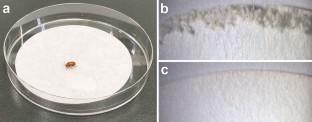Chemoecology ( IF 1.8 ) Pub Date : 2023-07-05 , DOI: 10.1007/s00049-023-00384-0 Ittetsu Kamata , Yoko Inui , Shoko Sakai

|
The importance of plant cuticular waxes in plant–herbivore interactions has become an area of increasing interest, but it has been poorly explored in chrysomelid beetles, one of the most important groups of insect pests. In this study, we investigated the effects of cuticular wax on feeding behaviors of Aulacophora femoralis (Chyrosomelidae), a pest of Cucurbitaceae crops. We analyzed chemical compositions of leaf cuticular waxes using gas chromatography–mass spectrometry. The compositions were significantly different among plant species; in particular, host (Cucumis maxima, C. pepo, C. sativus, Cucurbitaceae) and non-host (Pueraria lobata, Fabaceae) leaves had distinctive compositions of cuticular waxes. We examined if the cuticular wax induces feeding behaviors based on a bioassay using filter papers treated with cuticular wax extract from host or non-host leaves, or a synthetic mixture of straight-chain alkanes (n-alkanes), major components of the host cuticular waxes shared among different host species. We found that the beetles frequently left bite marks on the filter papers treated with n-alkanes but less frequently on those treated with cuticular wax extracts of host leaves. These results indicate that leaf cuticular wax n-alkanes stimulate feeding behavior, but are not cues for host selection.
中文翻译:

源自叶蜡的直链烷烃刺激葫芦叶甲虫 Aulacophora femolaris(叶甲科,鞘翅目)的摄食行为
植物角质层蜡在植物与草食动物相互作用中的重要性已成为人们日益关注的领域,但在叶甲虫(最重要的害虫类群之一)中对此的研究却很少。在这项研究中,我们研究了角质层蜡对葫芦科作物害虫Aulacophora femoralis (Chyrosomelidae)摄食行为的影响。我们使用气相色谱-质谱法分析了叶角质层蜡的化学成分。植物种类之间的成分存在显着差异;特别是宿主(Cucumis maxima、C. pepo、C. sativus、Cucurbitaceae)和非宿主(Pueraria lobata),豆科植物)叶子具有独特的角质层蜡成分。我们根据生物测定检查了表皮蜡是否会诱导进食行为,使用的滤纸经过寄主或非寄主叶子的表皮蜡提取物或直链烷烃(寄主表皮的主要成分)的合成混合物处理。不同宿主物种之间共享蜡。我们发现甲虫经常在用正烷烃处理过的滤纸上留下咬痕,但在用宿主叶子角质层蜡提取物处理过的滤纸上留下咬痕的情况较少。这些结果表明叶表皮蜡正烷烃刺激摄食行为,但不是宿主选择的线索。



























 京公网安备 11010802027423号
京公网安备 11010802027423号